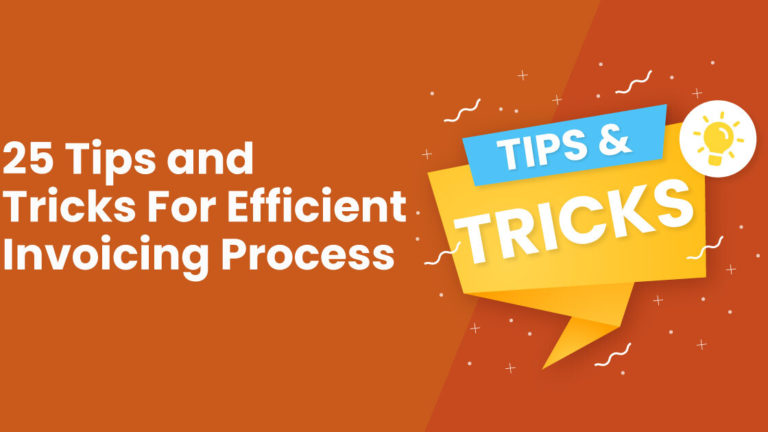25 Tips and Tricks For Efficient Invoicing Process
Invoicing is one process that significantly impacts a business’s bottom line and clientele. A streamlined invoicing procedure guarantees on-time payments and promotes happy customers. Whether you own a small business, a freelancing firm, or a large enterprise, improving your Invoicing process can increase productivity and improve your financial situation. This article discusses 31 valuable ideas for streamlining your invoicing process.

List of Tips and Tricks For Efficient Invoicing Process
1. Automate Invoicing:
An automated Invoicing system is one of the most effective ways to improve your Invoicing process, eliminating the need for manual entry, reducing errors, and saving time.
2. Choose a User-Friendly Software:
Choosing a user-friendly billing software is essential to ensure the seamless operation of your Invoicing process. A user-friendly interface allows swiftly creating, customising, and sending invoices without extensive training or technical expertise.
3. Standardise Templates:
Standardising templates for your invoices can streamline your invoicing process. Creating a consistent and professional format ensures that all essential information is included in each invoice.
4. Clear Payment Terms:
Clearly state payment terms and due dates on every invoice. Clarifying payment terms and policies can encourage prompt payment, reduce uncertainty and disagreements, and improve transparency.
5. Set Up Online Payments:
A crucial component of delivering a personalised experience is empowering clients to pay how they want. To provide various payment options, choose a payment processing system that supports all the payment methods.
6. Offer Multiple Payment Methods:
Multiple payment options can make payment easier for customers. Consider offering various payment options, such as credit card payments, cheques, cash or other online payment methods.
7. Implement Recurring Invoicing:
Recurring invoicing also enhances customer convenience, eliminating the need for clients to initiate payments each time. It fosters long-term customer relationships by offering a seamless and predictable invoicing experience.
8. Predefined Line Items:
Predefined line items also enable you to present a professional and organised image to clients by offering a clear breakdown of the services or products they are being billed for. This approach simplifies the invoicing process without compromising accuracy and clarity.
9. Centralise Customer Information:
Centralising customer information is a fundamental aspect of streamlining the invoicing process. By maintaining a centralised repository of customer details, businesses can efficiently access and manage vital information when creating and sending invoices.
10. Integrate with Accounting Software:
Integrating invoicing with accounting software streamlines the entire process. This saves time and facilitates better decision-making by providing a comprehensive view of your company’s financial status.
11. Use Cloud-Based Solutions:
Cloud-based accounting systems allow you to access your invoicing data and tools from virtually anywhere with an internet connection. It often comes with automated backups and data synchronisation, ensuring invoicing information remains secure and up-to-date.
12. Keep Invoices Detailed:
Keeping an invoice detailed is crucial to maintaining transparency and trust in your business transactions. Create a clear and accurate transaction record, including itemised descriptions, quantities, unit prices, and applicable discounts or taxes.
13. Offer Early Payment Discounts:
Encourage prompt payments by offering discounts for payments made before the due date. Early payment discounts foster positive client relations and cultivate a sense of loyalty by rewarding their timely financial commitments.
14. Send Reminders:
Set up automated reminders for pending payments to encourage timely settlements. These reminders can be customised to align with your payment terms and can be sent a few days before the due date or after a specified grace period.
15. Cross-Check Orders and Invoices:
Cross-reference orders and different invoices to ensure they match. This prevents invoicing for products/services that were not provided.
16. Conduct Regular Audits:
Performing a regular audit of your invoicing process is an essential practice that ensures precision, efficiency, and adherence to best practices.
17. Minimise Paper Usage:
Minimising paper usage in your invoicing process aligns with eco-friendly practices and brings significant operational advantages. You can reduce printing, postage, and physical storage costs by transitioning from traditional paper invoices to digital alternatives.
18. Data Backup:
To ensure all procedures are followed correctly, you need to provide all of your information and that records are accurate. For this, it is required to back up the data regularly and timely so everything is handled effectively.
19. Provide Detailed Contact Information:
Ensure your clients have easy access to your contact details in case of invoicing inquiries, including your business’s name and primary contact person, phone numbers, email addresses, and physical addresses.
20. Monitor Tax Regulations:
Changes in tax legislation and regulations may have a significant impact. Stay updated on tax regulations to ensure accurate tax calculations on invoices.
21. Periodically Review Pricing:
Regularly review your pricing strategy to ensure it aligns with market trends and your business’s value. You can make informed adjustments to reflect changing market dynamics by revisiting your pricing strategy regularly.
22. Seek Feedback:
Reaching out to your clients for feedback on your invoicing process is a valuable initiative that can yield insights you might have yet to consider.
23. Monitor Invoice Status:
Regularly keeping track of the status of your sent invoices is a crucial step in maintaining an organised and efficient invoicing process. By monitoring invoice status, you gain insights into successfully delivered, viewed and acknowledged invoices.
24. Provide Excellent Customer Service
Be responsive to client inquiries about invoices. When clients ask questions or concerns about their invoices, they must address these promptly and comprehensively.
25. Utilise Mobile Apps:
Use mobile billing apps for on-the-go billing. Mobile apps usually integrate with the central billing system, allowing seamless data synchronisation across devices.
Streamlining your invoicing process is crucial for running a successful and efficient business. These tips can improve cash flow, strengthen customer relationships, and enhance productivity.

